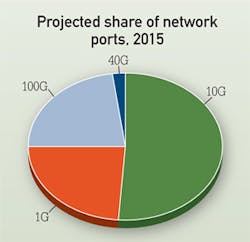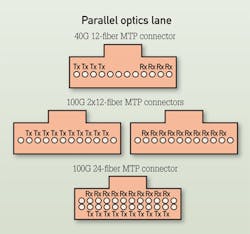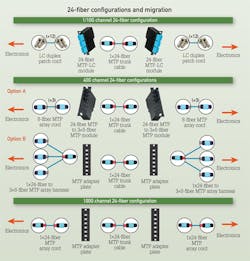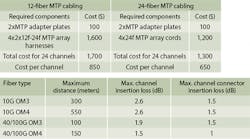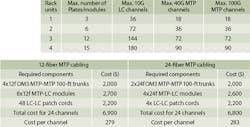12- and 24-fiber MPO-style cabling connectivity options for higher-speed Ethernet.
By Gary Bernstein, Leviton Network Solutions
East Africa is host to the extraordinary Great Migration. Every year millions of creatures—zebras, wildebeest, gazelles and many others—travel 1,800 miles and must overcome numerous threats to survive.
Data centers regularly undertake their own great migration, to ever-higher-speed networks. Applications from development software and enterprise resource planning (ERP) systems to consumer content, medical and academic records, and a host of others are continuously driving demand for greater bandwidth, and the network must keep pace.
10G, unimaginable little more than a decade ago, is now common in larger enterprises. Several 40G core, edge, and top-of-rack (ToR) switches are on the market today, including equipment from Force10, Cisco, Brocade, Arista, Extreme Networks, Hitachi and Blade Networks. Cisco, Alcatel-Lucent, Brocade and Juniper Networks have introduced 100G equipment as well. By 2015, higher-speed Ethernet will have about a 25-percent share of network equipment ports, according to Infonetics Research. The need is clear: A higher-speed Ethernet migration plan is rapidly becoming a matter of survival.
Is your network cabling optimized for this inevitable growth? Create a simple, cost-effective migration path by installing a structured cabling system that can support your future 40/100G networking needs. An ideal system will include the following.
- One simple, modular connectivity solution for legacy 1G and 10G applications that is also compliant to 40G and 100G
- One standardized connector theme able to support future high-bandwidth applications
- Preconnectorized components compliant to all current and anticipated industry standards
This article will provide a foundational understanding of laser-optimized multimode 40/100G structured cabling and discuss the pros and cons of 12- versus 24-fiber MPO/MTP cabling to help you prepare for high-speed Ethernet. MTP is a high-performance MPO connector manufactured and trademarked by US Conec, Ltd. Throughout this article I use the term MTP to refer to all MPO/MTP interfaces and connectors.
Understanding 40/100G
Planning for migration to higher-speed Ethernet can feel daunting. The standards for 40G and 100G are significantly different from previous generations; active equipment and transmission methods are unique. Even polarity takes on a new importance. The following sections explain these differences and will help you understand the options for 40/100G migration.
IEEE and TIA standards. Structured cabling systems design is always guided first by standards. IEEE creates the standards that define performance parameters, while TIA writes those that define how to apply the parameters to structured cabling systems. Familiarity with these standards will help you design your data center infrastructure to better support network upgrades.
IEEE 802.3ba 40-Gbit/sec and 100-Gbit/sec Ethernet is the only current standard that addresses the physical layer cabling and connector media maximums for 40G/100G fiber channel requirements (the standard does not address copper UTP/ScTP categories). IEEE 802.3ae 10-Gbit/sec Ethernet covers the fiber protocols for 10G transmission.
TIA-942 Telecommunications Infrastructure Standard for Data Centers establishes design criteria including site space and layout, cabling infrastructure, tiered reliability and environmental considerations. The standard recommends using the highest-capacity media available to maximize infrastructure lifespan. 10G equipment is the most frequently installed today, but 40G and 100G Ethernet will soon grow to become common networking speeds.
Now let’s discuss the structured cabling requirements needed to support 40/100G applications.
Active equipment interfaces. Fiber connectivity in higher-speed active equipment is being condensed and simplified with plug-and-play, hot-swap transceiver miniaturization. 1G and 10G networks commonly use the Gigabit interface converter (GBIC). For 8G Fibre Channel SAN and OTU2, as well as some 10G, the transceiver is the SFP+ (Small-form-factor Pluggable Plus). Interfaces for 40G and 100G active equipment include QSFP (Quad Small-form-pluggable Plus), CFP and CXP (100G form-factor pluggable).
MPO/MTP is the designated interface for multimode 40/100G and it’s backward-compatible with legacy 1G/10G applications as well. Its small, high-density form factor is ideal with higher-speed Ethernet equipment.
Parallel optics. Laser-optimized multimode 40G and 100G Ethernet employ parallel optics. Data is transmitted and received simultaneously on MTP interfaces through 10G simplex transmission over each individual strand of the array cable. Current IEEE channel/lane assignments for active equipment interfaces determine the transmission methodology.
Polarity. TIA-568-C.0 Generic Telecommunications Cabling for Customer Premises includes three MTP array cable polarity methods: A, B and C. In addition, TIA will soon be releasing two new addenda, TIA-568-C.0-2 and TIA-568-C.3-1, to specifically address the polarity and cabling requirements needed to support 40G and 100G applications. As the market moves toward 40G and 100G networking speeds, polarity becomes more and more important. With multiple channels within a single connector, all components must be manufactured with the same polarity; differences cannot be reconciled by flipping or switching connector position in the field. Many end users prefer Method B, as it has the same “straight-through” MTP array cord on both ends of the channel, which greatly simplifies upgrades.
With this background of the higher-speed Ethernet landscape, we’ll now discuss the pros and cons of 12- and 24-fiber cabling for 40G and 100G.
12- vs. 24-fiber cabling
All higher-speed Ethernet networks will use 12- or 24-fiber MTP trunks. However, an understanding of the differences between the two schemes will help you optimize your cabling plant with your next upgrade. The paragraphs that follow present migration, density, congestion and cost comparisons between 12- and 24-fiber solutions.
Migration. The graphics on pages 18 and 19 show 12- and 24-fiber system configurations for 1G-100G networks. With the 40G 12-fiber legacy configurations, a second trunk and another set of array harnesses will be needed to achieve 100-percent fiber utilization. For 100G, these additional components will be required for any 12-fiber legacy upgrade. On the other hand, with 24-fiber trunks, a single cable can support a 1G-100G channel and will simplify network upgrades immensely. 1G and 10G networks will link the trunks to active equipment with MTP-LC modules and LC duplex patch cords. When equipment is upgraded, modules and patch cords are exchanged for the appropriate new MTP components, with no need to install new trunks. In addition, limiting changes reduces the inherent risks to network security and integrity whenever move/add/change works is completed.
Density. Higher-density connectivity in the enclosure leaves more rack space for active equipment, reducing the total amount of floor space required. Twenty-four-fiber cabling has the obvious advantage. If the active equipment is configured for 24-fiber channel/lane assignments, enclosures can have twice as many connections with the same number of ports compared to 12-fiber (or the same number of connections using only half the ports).
For 40G networks, choose a 24-fiber MTP wiring scheme that delivers true 100-percent fiber utilization—no dark fibers or empty pins. With this configuration, density is doubled at the adapter plate/enclosure side, compared to 12-fiber 40G wiring schemes.
The table below shows 24-fiber cabling maximum enclosure density. A user’s achievable density may be less than what is noted in the table, depending on the enclosure model chosen. The column listing the maximum number of plates/modules refers to Leviton’s Opt-X brand products. Also worth noting, the 100G MTP channels require minimum 48-fiber trunk cables.
Congestion. The flipside of density is congestion. The more connectivity you are able to run in a given footprint, the more crowded it can become at the rack or cabinet. Here again, 24-fiber MTP trunks offer a huge benefit. Anywhere there is fiber, you will have just half the number of cables versus 12-fiber. Runs carry a lighter load, fibers are easier to manage, and improved airflow reduces cooling costs.
Cost. Twelve-fiber configurations may allow you to continue to use existing trunks when upgrading your equipment (if you already have 12-fiber MTP-MTP trunks), but likely will require additional trunks, more connectivity components, and other network modifications. In the long run, it’s many times more expensive to retain these trunks than to upgrade to 24-fiber up front.
Three tables on page 20 present 12- versus 24-fiber deployment cost comparisons for a 24-channel/48-fiber 10G network (top of page), 40G upgrade (middle) and 100G upgrade (bottom). The tables consider components-only costs. As they indicate, the migration cost savings with 24-fiber trunks increase as you move to higher networking speeds. For the 10G network, cost is almost equal. But 24-fiber trunks reduce end-user costs about 10 percent for a 40G upgrade, and almost 25 percent for a 100G upgrade. Factor in labor costs of installing additional trunks and other components with 12-fiber, and the difference is even greater.
Being prepared for 40/100G is essential; within a few short years high-speed Ethernet will be common in data centers across all types of organizations. Install a high-performance 24-fiber 40/100G MTP system and realize these benefits when it is time to upgrade your network.
- Fewer connectivity components to be replaced or added simplifies migration and reduces costs.
- Higher-density connectivity leaves more rack space for active equipment.
- Fewer trunks reduce cable congestion throughout the data center.
A 24-fiber higher-speed Ethernet MTP system will prepare your network for the future, lower your cost of ownership and maximize your return on investment.
Gary Bernstein is director of product management – fiber and data center with Leviton Network Solutions (www.leviton.com/networksolutions).
